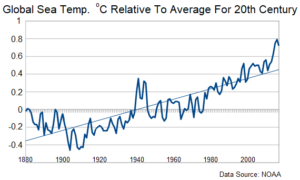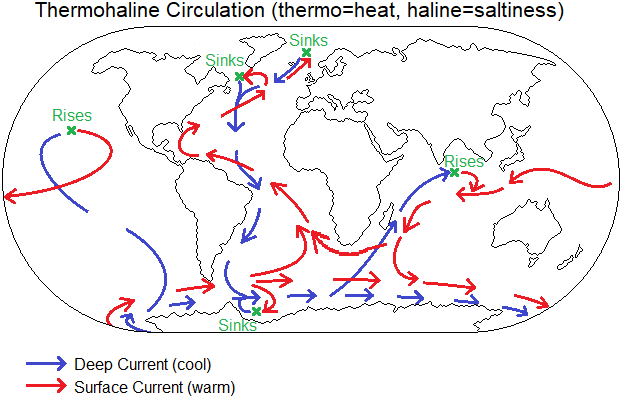Global warming combined with excess carbon dioxide are making significant changes to the water in our oceans. The primary changes are that the water is:
- warmer,
- more acidic (when carbon dioxide dissolves in water, some of it reacts to form carbonic acid: CO2+H2O->H2CO3), and
- deoxygenated.
The secondary changes, that are the changes that happen because the primary changes are happening, are:
- changes in ocean circulation,
- degradation of coastal ecosystems. Mangrove forests, which support huge fish nurseries and protect coastlines from erosion are adversely affected by acidic water. Coral reefs are more subject to bleaching, and there is a loss of breeding grounds,
- warming of adjacent land masses which melts permafrost and mountain glaciers,
- rising sea levels the volume of water increases as its temperature rises, which raises the sea level. This threatens the coastal settlements and cities. Not only because it floods the land, but because it disrupts transport, water supplies, sewage treatment and power supplies. Farmland is also threatened. This causes saltwater intrusion, especially damaging when it spills into aquifers,
- its warmer surface causes more extreme weather events. Storms and hurricanes are more severe and El Niño events are stronger. This results in droughts and floods,
- provision of less food, less carbon storage and less oxygen generation,
- changes in diversity and numbers of marine species,
- it increases the spread of diseases in marine species. Humans risk direct transmission of these diseases when consuming marine species,
- severe deoxygenation in deeper areas due to stratification of water masses,
- cold-water upwellings of nutrients that provide food for numerous species are less frequent.

Additionally:
- Over 93% of the excess heat generated since the 1970s has been absorbed by the ocean, even affecting the deep ocean,
- Sea surface temperature, ocean heat content, sea-level rise, melting of glaciers and ice sheets, CO2 emissions and atmospheric concentrations of greenhouse gasses are increasing at an accelerating rate,
- The Southern Hemisphere has the greater ocean warming overall, and this is contributing to the melting of the Antarctic ice shelves from below,
- The heat and CO2 held in the ocean are not permanently locked away, but are released back to the atmosphere when the sea surface warms, giving positive rapid feed-back to global warming.
- Large dead areas are being created in which nothing can live. Excess nutrients from agriculture end up being washed into the sea. There they cause excessive amounts of phytoplankton to reproduce. The phytoplankton live for a while and then die. When the phytoplankton die, they sink to the sea floor and are broken down by bacteria. The bacteria consume oxygen to do this. Because of the large amounts of oxygen being consumed, the biological processes change and the result is deoxygenated dead areas.

Winds move surface currents
Temperature and saltiness (salinity) move deep currents
The oceans circulation:
- Water evaporates in the tropics, leaving salty warm water (warm makes lighter, salt makes heavier, so balanced.
- As the Gulf Stream moves NE, moving 100 million cubic meters per second, it loses heat to the land. When it gets to the far North, some water freezes, making remaining water heavier.
- Water is now heavy and sinks. It sinks 4km to the bottom of the sea, falling in huge columns up to 15km wide.
- With climate change, the temperature in the North is warmer so:
- Melting glaciers and melting ice being fresh water dilute the saltiness so the water is lighter
- The water is warmer, hence lighter, and doesn’t sink so easily.
The result is that the Gulf stream is slower and might stop.
- If the Gulf Stream stops then:
- tropics would get hotter and drier, with more powerful storms and more desertification,
- polar regions would get cooler,
- this would drive stronger weather systems, and
- there would be less moderation of UK weather so colder, snowier winters (bad for crops) and hotter, drier summers giving lower crop yields.
- Climate change could stop the Thermohaline Circulation. This would increase major floods and storms, causing more severe weather and causing a collapse of plankton stocks or oxygen depletion. Oxygen depletion is a probable cause of past mass extinction events. If the oxygen is depleted, not only is there less to breathe, but bacteria digestion changes and produces methane (green house gas) and hydrogen sulphide (rotten eggs smell). This could lead to hydrogen sulphide poisoning of the atmosphere.